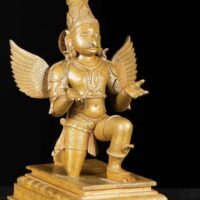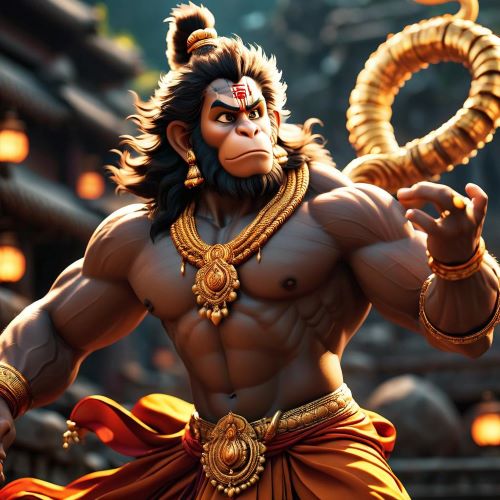Garuda : The Divine Eagle
Listen
At a glance
| Description | |
|---|---|
| Origin | Indian Mythology |
| Classification | Hybrids |
| Family Members | Kashyapa (Father), Vinata (Mother) |
| Region | India. Thailand, Indonesia, Cambodia |
| Associated With | Strength, Speed, Mount of Vishnu |
Garuda
Introduction
Garuda, the majestic eagle-like deity, holds a significant place in Indian mythology as the revered mount of Lord Vishnu. With a unique blend of eagle and human traits, Garuda is not merely a powerful bird but a symbol of divine attributes such as power, speed, and freedom. His role extends beyond being Vishnu’s mount, embodying the eternal struggle between good and evil. Celebrated in ancient texts like the Vedas, Puranas, and epics, Garuda represents the triumph of righteousness and the pursuit of spiritual liberation. This iconic figure’s legend is deeply embedded in Hindu cosmology, reflecting his importance in the pantheon.
Physical Traits
Garuda is depicted as a grand figure with a golden body, combining the head, wings, and talons of an eagle with the torso and limbs of a human. His vast wings symbolize flight and freedom, while his sharp talons reflect formidable power. Artistry often varies, with some images showing him with a white face and red wings, while others highlight his emerald hue, and he is frequently adorned with a golden crown, underscoring his status as the king of birds (Khagesvara). This hybrid form of Garuda, blending avian and human elements, signifies his role as a protector and a fierce warrior, embodying divine power and vigilance as he soars through the skies with a commanding presence.
Family
Garuda’s lineage is rich with mythological significance. He is the son of the sage Kashyapa and Vinata, one of his multiple wives, with Kadru, another wife, being the mother of the nagas (serpents). This familial connection underpins the enmity between birds and serpents in Hindu mythology. Garuda’s half-brother, Aruna, serves as the charioteer of the Sun God, Surya. Garuda himself is married to Unnati, and they have a son named Sumukha. His birth story is pivotal in Hindu mythology. Vinata, having competed with Kadru, was cursed to a state of servitude until Garuda’s birth. This curse and Garuda’s subsequent actions as a liberator highlight his role as a transformative figure within these ancient narratives.
Other names
Garuda is known by various names that reflect his diverse roles and attributes. Among these are Tarkshya and Vainateya, highlighting his multifaceted nature. His association with Lord Vishnu is emphasized by the name Vishnu Vahana, signifying his role as Vishnu’s mount. The name Suparna, meaning “having beautiful wings,” underscores his regal appearance, while Garutman points to his grandeur and powerful presence. Sahasraksha, meaning “thousand-eyed,” reflects his vast vision and awareness. Additional names like Suvarnakaya, meaning “golden-bodied,” and Garuda, derived from “guruḍa” which means “devourer,” further illustrate his formidable nature and role as the vanquisher of serpents (Nagantaka).
Powers and Abilities
Garuda is endowed with extraordinary abilities that make him a formidable figure in Indian mythology. Known for his unparalleled speed, he soars through the heavens with ease and can traverse great distances instantly. His immense strength allows him to carry even powerful deities like Vishnu and overcome formidable adversaries. His exceptional eyesight enables him to detect objects from vast distances, while his near-invulnerability lets him withstand divine weapons and fire. Additionally, Garuda possesses the power of speech and profound intelligence.
A defining moment in Garuda’s legend is his quest to rescue his mother from servitude by retrieving the amrita, the elixir of immortality, from the gods. His successful mission, marked by bravery and perseverance, led him to make a pivotal deal with Vishnu. In exchange for his freedom, Garuda agreed to become Vishnu’s mount, solidifying a significant bond central to Hindu mythology. His powers also include the ability to neutralize poisons, which is crucial in various mythological contexts, and his role as a protector symbolizes the ongoing struggle between good and evil. Garuda’s wing flapping is said to halt the cosmic rotation, further highlighting his influence in maintaining cosmic balance and order.
Modern Day Influence
Garuda’s influence extends significantly into modern culture and symbolism. In countries like Indonesia and Thailand, Garuda is prominently featured on national emblems, such as the Garuda Pancasila in Indonesia, which symbolizes national strength and unity. His image is also used by the Indian Air Force on its emblem and is reflected in various corporate logos and sports team mascots, highlighting his associations with power, courage, and excellence. Additionally, Garuda appears in contemporary media, including films, television shows, and video games, where his traditional attributes are adapted to fit modern narratives.
Beyond visual representations, Garuda’s legacy endures through cultural and religious practices. In India and Southeast Asia, he remains a significant figure in cultural festivals and religious ceremonies, maintaining his relevance in contemporary religious contexts. His story, marked by dedication, courage, and loyalty, continues to inspire values that resonate with people today. Garuda’s presence in modern symbols and media underscores his lasting appeal and the enduring impact of his mythological legacy.
Related Images
Frequently Asked Questions
What is lorem Ipsum?
I am text block. Click edit button to change this text. Lorem ipsum dolor sit amet, consectetur adipiscing elit. Ut elit tellus, luctus nec ullamcorper mattis, pulvinar dapibus leo.
What is lorem Ipsum?
I am text block. Click edit button to change this text. Lorem ipsum dolor sit amet, consectetur adipiscing elit. Ut elit tellus, luctus nec ullamcorper mattis, pulvinar dapibus leo.
What is lorem Ipsum?
I am text block. Click edit button to change this text. Lorem ipsum dolor sit amet, consectetur adipiscing elit. Ut elit tellus, luctus nec ullamcorper mattis, pulvinar dapibus leo.
What is lorem Ipsum?
I am text block. Click edit button to change this text. Lorem ipsum dolor sit amet, consectetur adipiscing elit. Ut elit tellus, luctus nec ullamcorper mattis, pulvinar dapibus leo.
What is lorem Ipsum?
I am text block. Click edit button to change this text. Lorem ipsum dolor sit amet, consectetur adipiscing elit. Ut elit tellus, luctus nec ullamcorper mattis, pulvinar dapibus leo.












